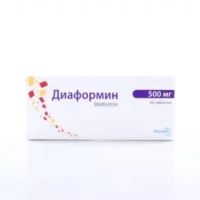Description
Duglimax (Metformin Hydrochloride) Tablets 500 mg/2 mg. №60
Ingredients
Composition: Each tablet contains Metformin hydrochloride 500 mg and 2 mg of additional ingredients.
Mechanism of Action
Pharmacodynamics: Metformin, the active ingredient in Duglimax tablets, primarily works by decreasing hepatic glucose production, reducing intestinal glucose absorption, and improving insulin sensitivity. These mechanisms contribute to lowering blood glucose levels in patients with type 2 diabetes mellitus.
Indications for Use
Indications: Duglimax tablets are specifically indicated for the management of type 2 diabetes mellitus in adult patients as part of an overall treatment plan that may include diet, exercise, and other medications.
Contraindications
Contraindications: Duglimax tablets should not be used in individuals with severe renal impairment, metabolic acidosis, or a history of lactic acidosis. Patients with these conditions are at increased risk of adverse effects from metformin therapy.
Side Effects
Adverse Reactions: Common side effects of Duglimax may include gastrointestinal symptoms such as nausea, vomiting, diarrhea, and abdominal discomfort. In rare cases, lactic acidosis can occur, especially in patients with predisposing factors. Regular monitoring and dose adjustments are crucial to minimize adverse effects.
Usage Instructions
Dosage and Administration: The recommended dosage of Duglimax is typically one tablet (500 mg) taken orally once daily with food. Patients should follow the instructions provided by their healthcare provider regarding dose titration and monitoring of blood glucose levels.
Benefits Compared to Analogues
Advantages: Clinical studies have shown that Duglimax exhibits comparable or superior efficacy in glycemic control compared to other antidiabetic agents. Its favorable safety profile, lower risk of hypoglycemia, and potential cardiovascular benefits make it a preferred choice for many patients and healthcare professionals.
Suitable Patient Groups
Population Considerations: Duglimax can be used in a wide range of patient populations, including adults with type 2 diabetes mellitus. However, caution is advised in elderly patients and those with renal impairment, as they may be more susceptible to the drug’s effects and require dose adjustments based on their individual health status.
Storage and Packaging
Storage Conditions: Duglimax tablets should be stored at room temperature away from moisture and heat. The packaging of Duglimax typically contains 60 tablets in a sealed container to maintain product integrity and potency.
Clinical Evidence and Effectiveness
Clinical Studies: Extensive clinical trials have demonstrated the efficacy and safety of Duglimax in managing type 2 diabetes mellitus. Research supports the role of metformin in improving glycemic control, reducing cardiovascular risk factors, and enhancing overall patient outcomes. Duglimax has established itself as a cornerstone therapy in the management of diabetes due to its proven effectiveness and favorable risk-benefit profile.





